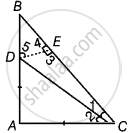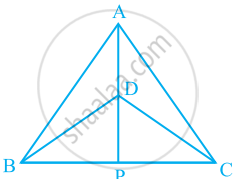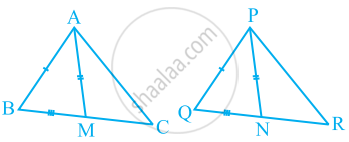Advertisements
Advertisements
Question
ABC is a right triangle such that AB = AC and bisector of angle C intersects the side AB at D. Prove that AC + AD = BC.
Solution
Given: In right angled ΔABC, AB = AC and CD is the bisector of ∠C.
Construction: Draw DE ⊥ BC.
To prove: AC + AD = BC
Proof: In right angled ΔABC, AB = AC and BC is a hypotensue ...[Given]
∴ ∠A = 90°
In ΔDAC and ΔDEC, ∠A = ∠3 = 90°

∠1 = ∠2 ...[Given, CD is the bisector of ∠C]
DC = DC ...[Common sides]
∴ ΔDAC ≅ ΔDEC ...[By AAS congruence rule]
⇒ DA = DE [By CPCT] ...(i)
And AC = EC ...(ii)
In ΔABC, AB = AC
∠C = ∠B [Angles opposite to equal sides are equal] ...(iii)
Again, in ΔABC, ∠A + ∠B + ∠C = 180° ...[By angles sum property of a triangle]
⇒ 90° + ∠B + ∠B = 180° ...[From equation (iii)]
⇒ 2∠B = 180° – 90°
⇒ 2∠B = 90°
⇒ ∠B = 45°
In ΔBED, ∠5 = 180° – (∠B + ∠4) ...[By angle sum property of a triangle]
= 180° – (45° + 90°)
= 180° – 135°
= 45°
∴ ∠B = ∠5
⇒ DE = BE [∵ Sides opposite to equal angles are equal] ...(iv)
From equations (i) and (iv),
DA = DE = BE ...(v)
∵ BC = CE + EB
= CA + DA ...[From equations (ii) and (v)]
∴ AD + AC = BC
Hence proved.
APPEARS IN
RELATED QUESTIONS
ABC is a right angled triangle in which ∠A = 90° and AB = AC. Find ∠B and ∠C.
ΔABC and ΔDBC are two isosceles triangles on the same base BC and vertices A and D are on the same side of BC (see the given figure). If AD is extended to intersect BC at P, show that
- ΔABD ≅ ΔACD
- ΔABP ≅ ΔACP
- AP bisects ∠A as well as ∠D.
- AP is the perpendicular bisector of BC.

Two sides AB and BC and median AM of one triangle ABC are respectively equal to sides PQ and QR and median PN of ΔPQR (see the given figure). Show that:
- ΔABM ≅ ΔPQN
- ΔABC ≅ ΔPQR

BE and CF are two equal altitudes of a triangle ABC. Using RHS congruence rule, prove that the triangle ABC is isosceles.
In two right triangles one side an acute angle of one are equal to the corresponding side and angle of the other. Prove that the triangles are congruent.
ABC and DBC are two triangles on the same base BC such that A and D lie on the opposite sides of BC, AB = AC and DB = DC. Show that AD is the perpendicular bisector of BC.
Prove that sum of any two sides of a triangle is greater than twice the median with respect to the third side.
Line segment joining the mid-points M and N of parallel sides AB and DC, respectively of a trapezium ABCD is perpendicular to both the sides AB and DC. Prove that AD = BC.
ABCD is a quadrilateral such that diagonal AC bisects the angles A and C. Prove that AB = AD and CB = CD.
ABCD is quadrilateral such that AB = AD and CB = CD. Prove that AC is the perpendicular bisector of BD.
